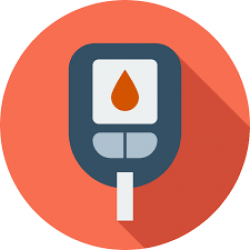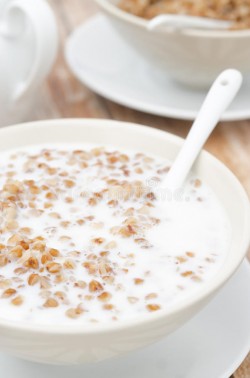0% - Gluten
0% - Sodium
0% - Chemicals
0% - Cholesterol
Magnesium, Iron
Potassium, Calcium
Fiber, Protein, Rutin
Phosphorus, Copper
Great for Diabetics
Home » Great for Diabetics
Low GI
Buckwheat is a complex carbohydrate, with a glycaemic index (GI) value of 51. Foods with a GI value of 55 or less are considered low.
GI is a ranking of carbohydrates on a scale of 1 to 100 according to the extent to which they raise the blood sugar after eating. Foods with a high GI are digested, absorbed, and metabolized rapidly and consequently cause large fluctuations in blood sugar levels. On the other hand, foods with a low GI are digested and absorbed much slower, resulting in a gradual increase in blood sugar and insulin levels. Low GI foods, therefore, are a better choice for those with both type 1 and type 2 diabetes.

Diabetes Management
Diabetics who are unfamiliar with buckwheat now have another tool in the complex and constant management of the disease. The high level of dietary fiber is certainly one of the reasons why it helps diabetic patients, because it significantly lowers the amount of blood sugar, and does so very quickly as well, sometimes in as little as 1-2 hours. Flour made from buckwheat was shown to have a stronger effect than regular wheat flour.
This blood glucose-lowering effect stems from the presence of a compound called chiro-inositol, found in buckwheat. Chiro-inositol mimics the appearance and chemical functionality of insulin and makes you more sensitive to insulin presence. This has proven very beneficial for that with type 1 diabetes, and further research is being done on other types of diabetes. Furthermore, buckwheat, along with other types of whole grains are great sources of magnesium, which is an essential part of nearly 300 enzymes in the human body, including those that affect the body’s use of glucose and insulin formation and release. High levels of magnesium have been associated with a reduced risk of type 2 diabetes, so buckwheat has both major types covered!

Buckwheat helps diabetes prevention
Buckwheat has a very low glycemic index, and the carbs present in it are slowly absorbed into the bloodstream, lasting your full stomach feel longer and giving you sustainable energy. Plus it helps you balance your blood sugar, preventing inflammation and even diabetes. This is due to the presence of D-chiro-inositol, which makes cells sensible to insulin.

Secret diabetes weapon
- The science behind it: Often associated with pancakes, this nutty whole grain has a "secret diabetes weapon" called D-chiro-inositol (DCI), a chemical compound that enhances insulin's sugar-lowering effects, Dr. Kazlauskaite says. Buckwheat also has fiber and magnesium and is low in calories. DCI is rarely found in other foods, but whole grains such as amaranth and farro are good carbohydratesfor those with diabetes.

Buckwheat Lowers Blood Sugar
In the study, published in the Dec. 3 issue of the Journal of Agricultural and Food Chemistry, researchers compared the effects of a single dose of buckwheat extract or a placebo on blood sugar levels in about 40 diabetic rats.
The rats were bred to have type 1 diabetes, which is the less common form of diabetes. People with type 1 diabetes (previously known as insulin-dependent diabetes) do not produce the hormone insulin needed to maintain normal blood sugar levels and are treated with daily insulin shots.
Researchers found that diabetic rats fed buckwheat extract prior to eating a meal containing sugar had blood sugar levels 12%-19% lower than the diabetic rats fed the placebo, which suggests that the extract can lower blood sugar levels after a meal.
Although the rats were bred to have type 1 diabetes, researchers say buckwheat may have a similar beneficial effect in animals with type 2 diabetes, and they plan to test that theory next. Type 2 diabetes is the most common form of diabetes and occurs when the body is unable to properly respond to insulin.
Researchers say the active ingredient in buckwheat thought to be responsible for the blood sugar lowering effects is chiro-inositol. This compound is found in high levels in buckwheat and rarely found in other foods.

Ideal food for people with diabetes
Buckwheat: This "grain" actually comes from a fruit seed making it an ideal food for those with gluten sensitivities and diabetes. Research findings have shown that buckwheat can actually lower blood sugar levels. Buckwheat is high in magnesium, phytonutrients, and dietary fiber.

Manage Diabetes
Diabetes can often be quite dangerous and its management can be fairly complex at times. Buckwheat contains fibers that lower the blood sugar in the body, helping with diabetes management.
It works quickly and can reduce the blood sugar within 1-2 hours as well. Buckwheat contains chiro-inositol, which essentially behaves like insulin, making its receptors more sensitive to its presence. This is especially beneficial for patients who have Type 1 diabetes. Buckwheat also has high quantities of magnesium in it, and it is a crucial part of almost all of the 300 enzymes that have a direct effect on the way the body uses and absorbs glucose and insulin. High levels of magnesium also help patients prevent type 2 diabetes.

Can Help Prevent Diabetes
Compared to many other carbohydrates and whole grains, buckwheat is low on the glycemic index. The complex carbohydrates found in buckwheat nutrition are absorbed into the bloodstream slowly, which help you to feel full for longer and support sustainable energy. This helps fight imbalances in blood sugar levels that can lead to inflammation, fatigue and even diabetes or metabolic syndrome.
Studies found that when diabetic patients consumed buckwheat over a two-month period, they experienced improvements in blood sugar control and reduced insulin resistance without any form of medication.

Better Blood Sugar Control and A Lowered Risk of Diabetes
The nutrients in buckwheat may contribute to blood sugar control. In a test that compared the effect on blood sugar of whole buckwheat groats to bread made from refined wheat flour, buckwheat groats significantly lowered blood glucose and insulin responses. Whole buckwheats also scored highest on their ability to satisfy hunger.
When researchers followed almost 36,000 women in Iowa during a six-year long study of the effects of whole grains and the incidence of diabetes, they found that women who consumed an average of 3 servings of whole grains daily had a 21 percent lower risk of diabetes compared to those who ate one serving per week. Because buckwheat is a good source of magnesium, it is also important to note that women who ate the most foods high in magnesium had a 24 percent lower risk of diabetes compared to women who ate the least.
Canadian researchers, publishing their findings in the Journal of Agricultural and Food Chemistry have found new evidence that buckwheat may be helpful in the management of diabetes. In a placebo-controlled study, a single dose of buckwheat seed extract lowered blood glucose levels by 12-19% at 90 and 120 minutes after administration when fed to laboratory animals with chemically-induced diabetes. No glucose reduction was seen in animals given placebo. The component in buckwheat responsible for its blood glucose-lowering effects appears to be chiro-inositol, a compound that has been shown in other animal and human studies to play a significant role in glucose metabolism and cell signaling. While researchers do not yet know precisely how it works, preliminary evidence suggests chiro-inositol makes cells more sensitive to insulin and may even act as an insulin mimic. Results of the Canadian study were so promising that one of the lead investigators, Roman Przbylski, is currently collaborating with Canadian-based Kade Research to develop new buckwheat varieties with much higher amounts of chiro-inositol. Although the animals used in this study had the equivalent of Type 1 diabetes in humans, the researchers are confident that buckwheat will exert similar glucose-lowering effects when given to animals with Type 2 diabetes, which is the next study on their agenda. Type 2 or non-insulin dependent diabetes, which is by far the most common form in humans (90% of diabetes in humans is Type 2), is characterized by an inability of cells to respond properly to insulin.
Buckwheat and other whole grains are also rich sources of magnesium, a mineral that acts as a co-factor for more than 300 enzymes, including enzymes involved in the body's use of glucose and insulin secretion.
The FDA permits foods that contain at least 51% whole grains by weight (and are also low in fat, saturated fat, and cholesterol) to display a health claim stating consumption is linked to lower risk of heart disease and certain cancers. Now, research suggests regular consumption of whole grains also reduces risk of type 2 diabetes. (van Dam RM, Hu FB, Diabetes Care).
In this 8-year trial, involving 41,186 particpants of the Black Women's Health Study, research data confirmed inverse associations between magnesium, calcium and major food sources in relation to type 2 diabetes that had already been reported in predominantly white populations.
Risk of type 2 diabetes was 31% lower in black women who frequently ate whole grains compared to those eating the least of these magnesium-rich foods. When the women's dietary intake of magnesium intake was considered by itself, a beneficial, but lesser—19%—reduction in risk of type 2 diabetes was found, indicating that whole grains offer special benefits in promoting healthy blood sugar control. Daily consumption of low-fat dairy foods was also helpful, lowering risk of type 2 diabetes by 13%. Get the benefits of both buckwheat and dairy by enjoying a hearty breakfast of hot buckwheat topped with low-fat milk and a spoonful of maple syrup.

Protection Against Diabetes
Both animal and human studies reveal that buckwheat flour can improve diabetes, as well as obesity, which is a risk factor for diabetes.
One of the ways buckwheat can have a beneficial effect on diabetes is by blocking the digestion of sucrose (table sugar). It does this by inhibiting the activity of sucrase, the name given to a number of enzymes that convert sucrose to fructose and glucose.
Canadian scientists conducted a placebo-controlled study to investigate buckwheat’s ability to manage diabetes. They administered buckwheat seed extract to rats that had chemically induced diabetes. When blood glucose levels were assessed at 90 minutes and 120 minutes after administration, the placebo group showed no change. By contrast, the buckwheat group was found to have blood glucose levels that were 12-19% reduced. The researchers attribute this effect to the buckwheat compound D-chiro-inositol, which is believed to play a significant role in glucose metabolism and cell signaling.
In fact, other studies have shown that D-chiro-inositol may make cells more sensitive to insulin. It appears to mimic the activity of insulin and may, therefore, lower blood levels of glucose.






















